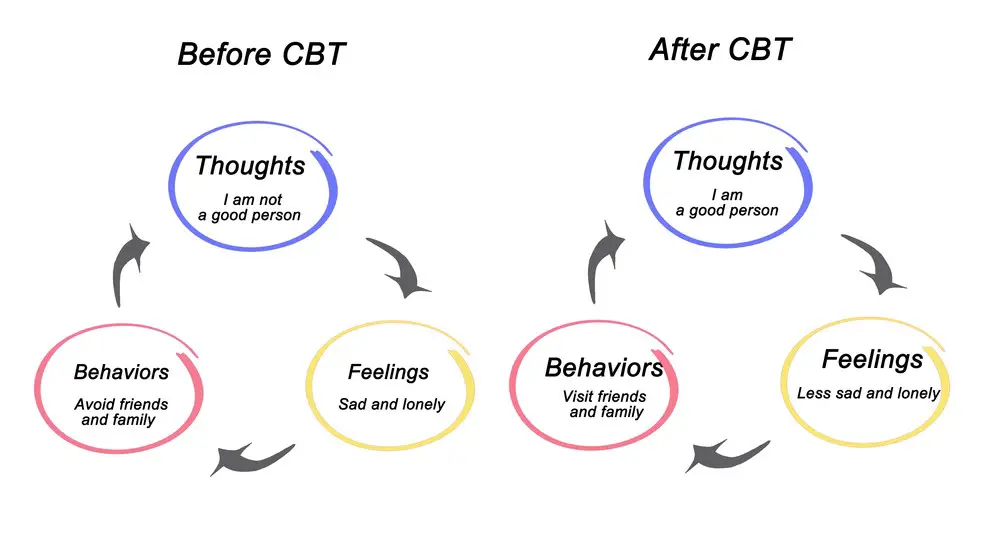As a BetterHelp affiliate, we receive compensation from BetterHelp if you purchase products or services through the links provided
Goal-oriented therapy is a powerful approach to emotional wellness and better mental health, focusing on achieving specific objectives and overcoming challenges. Instead of diving into the root causes of issues, this therapy aims to create a path toward desired outcomes by utilizing a person’s strengths and resources. With its dynamic nature and client-centered perspective, goal-oriented therapy has become increasingly popular among individuals seeking help to make meaningful changes in their lives.
This therapeutic approach emphasizes the client’s capability to create a better future by setting and working towards attainable goals. The therapist and the client work together to identify these goals and form strategies to achieve them in a reasonable timeframe. By focusing on solutions and emphasizing the client’s potential for growth, goal-oriented therapy fosters a sense of self-efficacy and confidence, leading to personal improvement and success.
Key Takeaways
- Goal-oriented therapy focuses on achieving objectives rather than exploring root causes.
- The therapeutic approach emphasizes clients’ strengths, resources, and potential for growth.
- Therapists and clients collaborate to identify and work toward attainable goals.

Goal-Oriented Therapy Overview
Goal-oriented therapy is an approach to mental health treatment that focuses on helping you identify and work towards specific goals you want to achieve. This therapy focuses less on the symptoms or issues bringing you to therapy and more on what you want to be different if therapy is successful.
Some of the benefits of goal-oriented therapy include:
- Empowerment: This approach encourages you to take an active role in your therapy by setting goals and working towards achieving them, helping you feel more in control of your life.
- Efficiency: Due to its targeted nature, goal-oriented therapy is generally brief compared to other therapy approaches, allowing you to see progress in less time.
- Customization: Since the therapy is tailored to your unique goals, it’s flexible and adaptable to your needs and circumstances.
When participating in goal-oriented therapy, it’s essential to set SMART (Specific, Measurable, Achievable, Relevant, and Time-bound) goals for the best possible outcomes. For example, instead of setting a vague goal like “I want to be happier,” try setting a more specific goal, such as “I want to practice gratitude daily for 30 days.”
Remember that goal-oriented therapy can be applied across various therapeutic approaches, including cognitive-behavioral therapy (CBT), psychoanalytic psychotherapy, and interpersonal psychotherapy (IPT). Your mental health professional can help you decide which approach best suits your needs and goals.
Key takeaway: Goal-oriented therapy is a brief, empowering, and customized approach to mental health treatment that empowers you to set and achieve your unique goals.
Psychotherapy Techniques
Solution-Focused Brief Therapy
Solution-Focused Brief Therapy (SFBT) is a short-term, goal-oriented psychotherapy approach that focuses on your strengths to help you create the future you desire. Developed by Steve de Shazer and Insoo Kim Berg, SFBT aims to find solutions in the present while looking forward to your future goals rather than dwelling on past problems.
During SFBT sessions, you and your therapist will:
- Identify your specific goals
- Explore past successes and strengths
- Develop a “miracle question” to envision your ideal future
- Generate small, achievable steps to reach your goals
This therapy method is highly collaborative and encourages you to be an active participant in the solution-building process. By emphasizing your strengths and resources, SFBT fosters a sense of empowerment and resilience on your journey toward achieving your goals. We will discuss this therapy a bit more further in this article.

Cognitive Behavioral Therapy
Cognitive Behavioral Therapy (CBT) is another goal-oriented psychotherapy technique that focuses on identifying and changing unhelpful thoughts, behaviors, and emotional patterns. By confronting these cognitive distortions, you can improve your overall well-being and achieve your desired goals.
CBT may involve the following steps:
- Recognizing and challenging negative thought patterns
- Developing healthy coping strategies for stressful situations
- Practicing problem-solving skills
- Gradually facing and overcoming feared situations or objects
- Setting specific and measurable behavioral goals
CBT is typically a short-term therapy, with sessions focused on practical skill-building exercises and homework assignments to practice new strategies outside of sessions. This structured approach allows you to address your goals systematically and effectively, creating lasting change.
Key takeaway: Solution-Focused Brief Therapy and Cognitive Behavioral Therapy are goal-oriented psychotherapy techniques designed to help you achieve your desired outcomes. While SFBT emphasizes your strengths and a forward-looking perspective, CBT addresses cognitive distortions and develops practical coping strategies.

Therapist’s Tools and Resources
Several techniques and tools can help clients identify and work towards their goals in goal-oriented therapy. This section will outline therapists’ three common methods: the Miracle Question, Scaling Questions, and Coping Questions.
The Miracle Question
The Miracle Question is a powerful technique that encourages clients to envision a future where their problems are resolved. Therapists can identify the specific changes and desired outcomes by asking clients to imagine waking up to find all their issues have disappeared (source). Discussing this hypothetical situation can help clients clarify their goals and think about the steps they would need to take to achieve them.
Scaling Questions
Scaling Questions are another valuable tool in goal-oriented therapy. These questions ask clients to rate various aspects of their situation on a numerical scale, such as their confidence in achieving a goal, satisfaction with their progress, or the intensity of a problem. By having clients regularly rate their progress, therapists can monitor changes and help clients recognize improvements over time. Additionally, scaling questions can be a helpful way of breaking down goals into smaller, more manageable steps.
Coping Questions
Coping Questions focus on clients’ strengths and strategies to overcome obstacles. By asking clients how they’ve managed to cope with challenges in the past, therapists can highlight their resilience and explore ways of applying these successful strategies to current situations. This approach encourages clients to acknowledge the resources and abilities they possess, which can be invaluable when working towards achieving their therapeutic goals.
Throughout this process, utilizing resources such as Therapist Aid’s worksheets can be helpful for both therapists and clients to track progress and maintain focus on the goals at hand. Integrating these tools and techniques into therapy sessions can facilitate a more effective and goal-focused therapeutic experience.
 The Therapeutic Approach
The Therapeutic Approach
In goal-oriented therapy, practitioners focus on helping you, the client, identify and work towards your desired goals. This therapeutic approach differs from other methods, emphasizing the individual’s resources and strengths to reach their potential. It helps you establish realistic expectations to understand better the process of achieving your desired changes.
As a client, you’ll collaborate with your therapist to set specific, measurable, attainable, relevant, and time-bound (SMART) goals. This process will help ensure that your goals are both realistic and achievable. Some common goals in therapy might include fostering behavioral change, enhancing your ability to establish and maintain relationships, improving your coping skills, and promoting better decision-making.
Goal-oriented therapy incorporates various therapeutic approaches to fit your individual needs. One such approach is, as mentioned above, solution-focused brief therapy (SFBT), a short-term, goal-focused method. SFBT leverages your strengths and resources to create your desired future without dwelling on past problems or issues.
In this type of therapy, you’ll work closely with your therapist to:
- Identify your strengths and resources
- Visualize the future you want and develop achievable goals
- Establish milestones to monitor your progress
- Develop strategies to help you overcome obstacles
- Foster a sense of self-efficacy in your ability to achieve your goals
Remember, goal-oriented therapy is a collaborative effort between you and your therapist. By actively engaging in the process, utilizing your strengths, and staying focused on your goals, you’ll be better equipped to make meaningful progress toward achieving your desired life.

Challenges and Solutions in Therapy
Brief Family Therapy
With a brief family therapy, it is common to face difficulties. However, several solutions exist to overcome these challenges.
- Encourage open communication: Encourage every family member to express their thoughts and feelings openly to feel valued and heard.
- Focus on strengths: Identifying and emphasizing each family member’s unique strengths can help build trust and confidence within the group.
- Set goals together: Collaborate with your therapist to establish realistic and achievable goals that promote positive change in family dynamics.
Remember, brief family therapy is a powerful tool for bringing families closer together and addressing underlying issues in a short time frame.
Therapy for Depression and Anxiety
In therapy for depression and anxiety, overcoming challenges can be tough but not impossible. Here are some valuable strategies to help you cope:
- Identify triggers: Be mindful of situations or stimuli that may contribute to feelings of anxiety or sadness. Recognizing these triggers is the first step in managing your response to them.
- Practice relaxation techniques: Implement techniques such as deep breathing, progressive muscle relaxation, and meditation to help reduce stress and anxiety.
- Set achievable goals: Break down your long-term goals into smaller, attainable tasks. This can make them feel less overwhelming and allow you to track your progress more effectively.
- Establish a support network: Reach out to friends, family, or support groups who understand your struggles and can offer guidance.
By implementing these strategies, you can overcome the challenges of dealing with depression and anxiety through goal-oriented therapy. Remember that it’s normal to experience ups and downs, but with dedication and support, you’ll continue to progress toward a healthier, happier future.
Applications of Goal-Oriented Therapy
Goal-oriented therapy can be applied in various settings, addressing individual and relational needs. This section will focus on three key applications: therapy in schools, family therapy, and therapy for couples.
Therapy in Schools
Educators and mental health professionals can help students develop academic and personal targets by incorporating goal-oriented therapy in schools. This approach can significantly impact students’ overall well-being and performance. Some strategies that can be employed in a school setting are:
- Encouraging students to identify and prioritize their academic and personal goals
- Collaborating with students to develop actionable plans to achieve these targets
- Regularly monitoring and reviewing progress, offering support and guidance as needed
Family Therapy
Regarding family therapy, goal-oriented approaches can help families resolve conflicts and improve communication. By focusing on the objectives that family members set together, families can:
- Identify shared goals for improving interaction patterns and dynamics
- Collaborate to create realistic steps to achieve these goals
- Track progress and celebrate milestones together, fostering a sense of unity and cooperation
Working with a therapist, families can leverage their strengths and find effective solutions to overcome challenges, leading to a happier, more harmonious home environment.

Therapy for Couples
Couples encountering difficulties in their relationship may benefit from goal-oriented therapy. This approach can help partners identify the desired outcomes for their partnership and work collaboratively to achieve them. Solution-focused therapy for couples can enhance relationships and lead to:
- Improved communication and understanding between partners
- Rekindled affection and intimacy
- Strengthened trust and commitment to one another
Couples can find ways to appreciate their strengths as a partnership and move beyond their challenges by concentrating on the future and their shared objectives.
Remember that these applications of goal-oriented therapy can be highly practical in promoting positive change and growth in different aspects of your life. By focusing on your goals and working collaboratively, you can overcome obstacles and lead a more fulfilling and healthy life.
Client Progress and Success
In goal-oriented therapy, your progress and success are closely aligned with the positive changes you experience as you work towards your objectives. By focusing on specific goals, you can track your achievements and witness tangible improvements in your life.
To ensure smoother progress, follow these helpful strategies:
- Collaboration: Working closely with your therapist, you can identify clear, attainable goals and develop a tailored plan to achieve them. This collaborative approach helps you feel more involved in your therapy, contributing to better outcomes.
- Flexibility: Be open to modifying your goals as you advance in therapy. Sometimes, circumstances change or new insights emerge, requiring an adjustment in your objectives. Don’t hesitate to discuss these changes with your therapist.
- Acknowledging small wins: Celebrate even the tiniest milestones on your journey. Recognizing these achievements can boost your motivation and confidence, leading to more significant positive change.
As you progress in your goal-oriented therapy, look for these signs of success:
- Improved relationships: You might notice better communication and more harmonious interactions with your loved ones, thanks to the skills you’ve acquired in therapy.
- Increased self-confidence: As you achieve your goals and witness positive changes in your life, your self-esteem and belief in your abilities will likely increase.
- Enhanced decision-making: Goal-oriented therapy can help you better understand your values and priorities, aiding in more confident and informed decision-making.
- Better coping skills: Therapy equips you with the tools to handle situations more effectively, reducing stress and improving your overall well-being.
Remember, there’s no one-size-fits-all approach in therapy. Your progress and success depend on your dedication and cooperation; staying patient and open-minded throughout the process is essential. Remember that any progress, big or small, is a testament to your commitment to change.
Training and Credentials for Practitioners
Goal-oriented therapy is a valuable approach to helping clients make meaningful, positive life changes. As a practitioner, you’ll need the proper training and credentials to implement this method effectively. One popular form of goal-oriented therapy is Solution-Focused Brief Therapy (SFBT), developed by Steve de Shazer and Insoo Kim Berg.
To become a proficient SFBT therapist, you should pursue a psychology, counseling, or social work degree. From there, you can seek specific Solution-Focused training to deepen your knowledge and enhance your skills in this therapeutic approach. Many workshops, seminars, and online courses are available to help you become an effective practitioner in SFBT.
Some essential components of SFBT training typically include:
- Understanding the theoretical framework of SFBT
- Practicing solution-focused questioning techniques
- Mastering the art of goal-setting with clients
- Learning to recognize client strengths and resources
Once you’ve completed your training, you’ll want to obtain the appropriate credentials. While there’s no specific certification for goal-oriented therapy, you can pursue certifications in specialized areas like SFBT. These credentials can add credibility to your practice and demonstrate your commitment to professional development.
In addition to SFBT, there are other goal-oriented practices to explore. By expanding your skill set in these areas, you can better serve your clients and continuously grow as a practitioner. Remember, goal-oriented therapy is more than just a model; it’s a stance that you can blend with various evidence-based practices to create a tailored approach for each client.
As you advance in your career, keep an open mind and remain dedicated to refining your skills in goal-oriented therapy. By doing so, you’ll be well-prepared to empower your clients and help them achieve lasting change.
? Is Goal-oriented Therapy Right for You? The Ins and Outs ?
Goal-oriented therapy isn’t a one-size-fits-all solution, but it has unique strengths that make it more suitable for certain individuals and less so for others. Understanding whether it aligns with your needs can help you get the most out of your therapeutic experience.
Who It’s For:
- Action-Oriented Individuals: If you like setting objectives and ticking boxes, this approach will resonate with you.
- Short-Term Challenges: Dealing with a specific issue like stress at work, time management, or relationship problems? Goal-oriented therapy is excellent for targeted solutions.
- People Looking for Quick Progress: If you’re keen to see tangible changes in a relatively short time frame, this therapy style fits the bill.
Who It’s Not For:
- Deep-Rooted Emotional Issues: If your concerns stem from long-standing emotional trauma, you mig
Conclusion
In goal-oriented therapy, you focus on identifying and moving toward the objectives you want to achieve. This approach encourages brief sessions and best uses available resources, promoting efficient progress. Following a goal-oriented practice allows you as a client, to clearly understand what you’d like to change and how to reach your desired outcomes.
Exploring different therapies incorporating goal-oriented practices, such as cognitive behavior therapy and interpersonal psychotherapy, might help you find the best approach that suits your needs. Therapists also benefit from adopting a collaborative attitude towards setting goals, as this fosters a solid therapeutic alliance and promotes effective behavior change.
Remember, the journey toward your goals might not always be straightforward, and it’s crucial to remain flexible and open to adjustments as needed. As you progress through therapy, you may discover new insights, allowing your goals to evolve with time.
To make the most out of goal-oriented therapy, keep these tips in mind:
- Set specific and realistic goals.
- Collaborate with your therapist in the process.
- Stay open to change and growth.
- Embrace the advantages of brief and focused sessions.
Ultimately, the ultimate goal should be to embrace a fully functioning life enriched by personal achievements and enhanced well-being. Stay committed to your journey, and remember that your therapist is there to support you every step of the way.
Frequently Asked Questions

What are common techniques used in goal oriented therapy?
In goal-oriented therapy, therapists utilize various techniques to help clients achieve their goals. Some typical techniques include:
- Identifying and clarifying goals: Collaborating with the client to establish specific, achievable goals.
- Assessing progress: Regularly reviewing and evaluating the client’s progress toward achieving their goals.
- Problem-solving: Developing strategies to overcome obstacles and challenges hindering the client’s progress.
- Skill-building: Teaching clients essential skills like assertiveness, communication, and coping mechanisms.
One key takeaway is that goal-oriented therapy techniques are collaborative and focused on the client’s improvement.
How does goal oriented therapy differ from traditional therapy approaches?
Goal-oriented therapy differs from traditional therapy approaches in its focus on achieving specific goals and addressing immediate concerns. While traditional approaches often involve exploring underlying issues and past experiences, goal-oriented therapy prioritizes helping clients move forward by developing practical solutions to current problems. The main difference between the two approaches lies in their level of focus: goal-oriented therapy is more targeted and action-oriented, while traditional therapy may explore deeper or broader aspects of a client’s life.
What are the key principles of solution-focused therapy?
Solution-focused therapy is a subset of goal-oriented therapy that emphasizes client strengths and possible solutions. Key principles of solution-focused therapy include:
- Emphasizing the client’s strengths and resources.
- Collaborative goal setting.
- Focusing on solutions rather than problems.
- Establishing small, manageable steps.
- Maintain a positive, forward-looking perspective.
Remember that solution-focused therapy empowers clients by helping them build their problem-solving skills and capitalize on their strengths.
In which cases is goal oriented therapy most effective?
Goal-oriented therapy is particularly effective when it comes to addressing specific issues or concerns, such as:
- Improving communication skills.
- Managing stress or anxiety.
- Enhancing relationships.
- Coping with life transitions, like career changes or the end of a relationship.
Goal-oriented therapy can be a valuable approach for those seeking practical solutions and concrete outcomes.
What are potential drawbacks of using goal oriented therapy?
While goal-oriented therapy has many benefits, there are potential drawbacks to consider:
- It may not be well-suited to exploring deeper or more complex emotional issues.
- Clients may become overly focused on achieving specific goals, missing broader opportunities for personal growth.
- The therapy may not be effective for clients who struggle with setting or maintaining goals.
Keep in mind that goal-oriented therapy is not a one-size-fits-all approach, and its effectiveness will depend on the specific needs and context of the client.
How does goal setting enhance therapy outcomes?
Goal setting in therapy can enhance outcomes by providing clients with a clear direction, facilitating motivation, and fostering a sense of accomplishment. By setting specific, achievable goals, clients can better track their progress, identify challenges, and develop strategies to overcome obstacles. This process can empower clients to take control of their lives and achieve meaningful change.
In sum, goal setting is a powerful tool in therapy that can help clients focus their energies, stay motivated, and achieve their desired outcomes.
About Jacob Maslow
After surviving the traumatizing events of 9/11, I took it upon myself to heal through helping others. I was Mr. Mom for many years and understand from first-hand experience the lonely paths you have to walk as a partner and parent when leaving an unhealthy relationship.
We’re all echoing in a dark space that doesn’t have to be this empty, and that’s been my mission since finding solace and recovery in therapy: To help comfort others who are still in shock and at the prime of their struggle.
I came across BetterHelp after searching for this type of community. I wanted to belong to a body of proactive therapists and supportive therapy veterans that allowed me to see other sides of the story.
It was unconventional, and that’s what attracted me most. During my most challenging times, when my ex-wife completely cut me off from my children, I found comfort and clarity through BetterHelp.
Instead of being chained to a strict therapist recommendation, I was in charge of who I felt understood my struggle most. That allowed me to find my true peace, as I was reunited with those who read behind my words and had first-hand experience with my trauma.
Recovery is a choice; with BetterHelp, that choice will be a few clicks away. You can join their couples-oriented platform, Regain.us, for those stuck with family estrangement and toxic relationship patterns.
- Stress Management: What is the Relationship Between Stress and Addiction? - June 28, 2024
- Exploring Techniques to Maintain a Healthy Lifestyle without Drugs - May 28, 2024
- How Acupuncture Helps Treat Chronic Fatigue Syndrome - May 28, 2024
This site contains affiliate links to products. We will receive a commission for purchases made through these links.


 The Therapeutic Approach
The Therapeutic Approach

